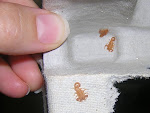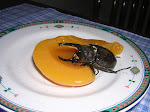I've spent this week -- "spring break" as it were -- at the Oregon State University Hermiston Agricultural Research and Experiment Center in northeastern OR. Other than plaguing my advisors with questions out here, I am processing 54 crayfish (Pacifasticus leniusculus) that I collected along the Umatilla River late last summer just after moving to Oregon. My task with the tasty crustaceans this week: digesting. Acid digesting. It sounds so much more benign than what it is: the dissolving of dried flesh in concentrated, heated acids. Creepy, yes. And not just because I'm perpetually afraid of getting burnt.


In a magic elixir of nitric acid, hydrogen peroxide and hydrochloric acid,
these crayfish dissolved in less than three hours.
these crayfish dissolved in less than three hours.
I know, I know. I'm an entomologist!! At the very least, a burgeoning ecologist... How did I wind up with a toxicological project? I dunno. There are a lot of scientists who start out elsewhere and somehow wind up as entomologists, so maybe it's the universe trying to balance itself. But I won't go willingly into toxicology. While the crays are a required part of my graduate research, as per my funding source, I'm still hopeful funds will be found for me to incorporate at least ONE insect genus. Hopefully my grant writing will produce, but no luck so far there. Meantime, I go aquatic insect collecting to cheer myself up, and I'm trying not to think about graduating with a MS thesis on freshwater crustaceans (wondering who'll hire me as an "entomologist"). Admittedly, there are worse things to stew over these days than the fate of one's career now aren't there? At least I am in graduate school...

+reduced.jpg)


3 comments:
The obvious question for me is: do the crayfish eat bugs?
If they eat bugs, can't you study the metal content of the bugs in concert with the crayfish?
Hi Dan! The crays are ominivores, so they eat insects, small fish (if they can get them) plant materials...
As for looking at the metal concentrations in insects, too, yes you can do that. It makes sense to. And it is the perfect compliment to the cray data I suggested we incorporate. But funds are very tight. And so is time and expertise. Adding insects seems simple enough, but it's many more layers of work, from collecting, ID, drying/weighing, acid digesting, and running through the ICP-MS. If this were a PhD project, and we had funds for the additional sampling & processing, no problem. But I have one summer of data collection, and need to have my samples processed, analyzed, and thesis written/defended by end of spring term '10. Plus I'm taking classes each term. Ikes!!
The world is never more imperfect than when you're doing research.
Post a Comment